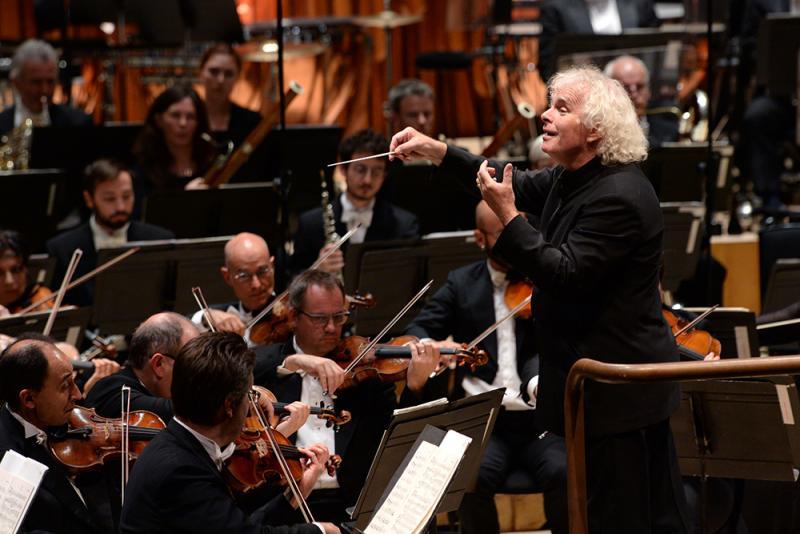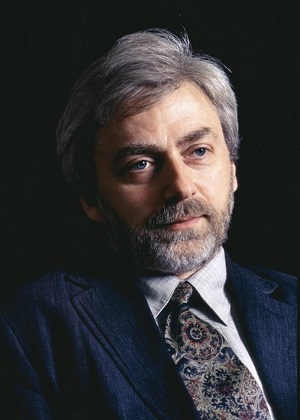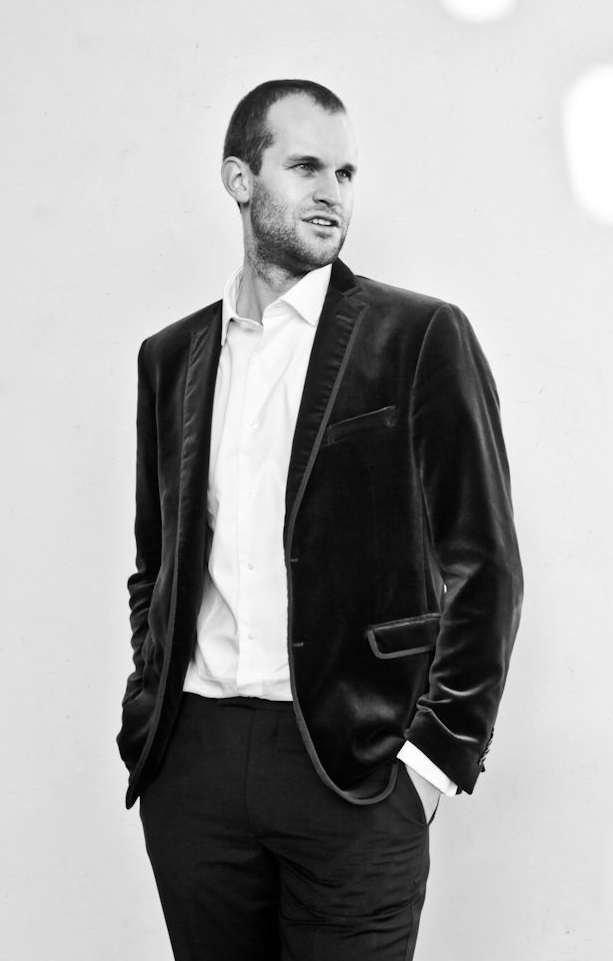Zimerman, LSO, Rattle, Barbican review - a diverse Bernstein centenary | reviews, news & interviews
Zimerman, LSO, Rattle, Barbican review - a diverse Bernstein centenary
Zimerman, LSO, Rattle, Barbican review - a diverse Bernstein centenary
A spectacular showcase, both serious and light, 'Wonderful Town' complete with encore revelry

Leonard Bernstein is 100 already. Actually, he’s not – his centenary falls in 2018, but the LSO, an orchestra he conducted many times, is building up to the anniversary with a series of concerts featuring his three symphonies.
The big news in the first half was a rare appearance by the elusive Krystian Zimerman (pictured below, image Hiromichi Yamamoto), as piano soloist in the symphony. Bernstein and Zimerman make a curious combination. Bernstein’s music is all big, direct gestures, while Zimerman’s pianism is all subtlety and nuance. But it was a constructive tension: for all his pastel shades of piano tone, Zimerman is also a direct communicator, clearly delineating Bernstein’s thematic ideas and patiently narrating their evolution. There is little in this score to show off the lyrical cantabile that makes his Chopin unique, but there are many sides to Zimerman’s art. His staccato touch is round and delicate, but also has the focus of tone that Bernstein requires. And, while the solo part is not particularly virtuosic – or rather seemed effortless to Zimerman – the few florid outbursts were delivered with the grace and elegance that marks him out as one of the true greats.
 The symphony is subtitled “The Age of Anxiety”, after the Auden poem that inspired it. Bernstein structured the work closely on the poem, but it communicates Auden’s ideas in more abstract terms, about the search for meaning in the post-war world. It was partly conceived for dance, as was clear from Simon Rattle’s energetic direction from the podium. Zimerman was in poor health, and coughed continuously throughout the performance. That didn’t affect his playing, but it forced Rattle to accommodate him more, no small task given the huge orchestral textures he was also marshalling. But the London Symphony was on top form, and readily responsive to his always clear direction. Towards the end, Bernstein resorts to some crude block chord effects, revealing some minor ensemble problems from the otherwise impeccable orchestra. That’s a minor gripe though, given the quality of the music-making, and especially given the change of pace seamlessly achieved after the interval.
The symphony is subtitled “The Age of Anxiety”, after the Auden poem that inspired it. Bernstein structured the work closely on the poem, but it communicates Auden’s ideas in more abstract terms, about the search for meaning in the post-war world. It was partly conceived for dance, as was clear from Simon Rattle’s energetic direction from the podium. Zimerman was in poor health, and coughed continuously throughout the performance. That didn’t affect his playing, but it forced Rattle to accommodate him more, no small task given the huge orchestral textures he was also marshalling. But the London Symphony was on top form, and readily responsive to his always clear direction. Towards the end, Bernstein resorts to some crude block chord effects, revealing some minor ensemble problems from the otherwise impeccable orchestra. That’s a minor gripe though, given the quality of the music-making, and especially given the change of pace seamlessly achieved after the interval.
Wonderful Town was written in 1953, so just four years after the symphony, but it’s a different world. Rattle suggests in the programme that we can hear the first traces of West Side Story in the score. And so we can, but this is still fairly conventional show music, even if done with superior talent. The story tells of two sisters, Eileen (Danielle de Niese) and Ruth (Alysha Umphress), who come to New York from rural Ohio, and get into all sorts of scrapes (Eileen starts Act II in jail), before Ruth finally finds love, thus preventing their return to the sticks. Along the way, librettists Betty Comden and Adolph Green find as many situations as possible to show off Bernstein’s talents, weaving every imaginable popular idiom of the day into the music.
This “concert version” was a selection of the main numbers, plus a few instrumental interludes, but with most of the dialogue cut. That was plenty to get the gist of the story, as was the minimal stage action – entering and exiting, some interaction between the characters and some dancing, too. The LSO was reconfigured as a deluxe pit band, with the brass and a sax section as a separate unit stage right and the double basses raised behind the ensemble. The Broadway feel was enhanced by some coloured lighting and by amplification for all the soloists, most of whom didn’t need it, but it did allow for some effective vocal acting without worries about projection. The London Symphony Chorus were also involved, their vocal contributions mainly restricted to unison support in the choruses, though they were also called upon for clapping, finger snaps, and a little hand jiving.
 Umphress and de Niese were both impressive in the lead roles, and well cast, Umphress dominating the proceedings with her cabaret repartee, with de Neise (slightly) more demure and operatic. Most of the remaining cast took multiple parts, so the details of the story were quickly forgotten. The opening “Christopher Street” showcased an impressive Ashley Riches (pictured right). Duncan Rock was convincing as the washed-up footballer Wreck, and Nathan Gunn gave a commendable turn as the love interest, Bob, a thankless task though, given that his solo and later duet are among the weakest numbers.
Umphress and de Niese were both impressive in the lead roles, and well cast, Umphress dominating the proceedings with her cabaret repartee, with de Neise (slightly) more demure and operatic. Most of the remaining cast took multiple parts, so the details of the story were quickly forgotten. The opening “Christopher Street” showcased an impressive Ashley Riches (pictured right). Duncan Rock was convincing as the washed-up footballer Wreck, and Nathan Gunn gave a commendable turn as the love interest, Bob, a thankless task though, given that his solo and later duet are among the weakest numbers.
It added up to a long evening, but nobody seemed to mind. Even so, this “concert version” could do with a bit more trimming; the instrumental interludes could go, and some of the solo numbers, too. It also has an abrupt ending. But Rattle had the ideal solution, an encore of the conga number. The first time round this had members of the chorus and the entire second violin section dancing, and for the encore, much of the audience joined the line too.
rating
Explore topics
Share this article
The future of Arts Journalism
You can stop theartsdesk.com closing!
We urgently need financing to survive. Our fundraising drive has thus far raised £49,000 but we need to reach £100,000 or we will be forced to close. Please contribute here: https://gofund.me/c3f6033d
And if you can forward this information to anyone who might assist, we’d be grateful.

Subscribe to theartsdesk.com
Thank you for continuing to read our work on theartsdesk.com. For unlimited access to every article in its entirety, including our archive of more than 15,000 pieces, we're asking for £5 per month or £40 per year. We feel it's a very good deal, and hope you do too.
To take a subscription now simply click here.
And if you're looking for that extra gift for a friend or family member, why not treat them to a theartsdesk.com gift subscription?
more Classical music
 Echo Vocal Ensemble, Latto, Union Chapel review - eclectic choral programme garlanded with dance
Beautiful singing at the heart of an imaginative and stylistically varied concert
Echo Vocal Ensemble, Latto, Union Chapel review - eclectic choral programme garlanded with dance
Beautiful singing at the heart of an imaginative and stylistically varied concert
 Scott, Irish Baroque Orchestra, Whelan, RIAM, Dublin review - towards a Mozart masterpiece
Characteristic joy and enlightenment from this team, but a valveless horn brings problems
Scott, Irish Baroque Orchestra, Whelan, RIAM, Dublin review - towards a Mozart masterpiece
Characteristic joy and enlightenment from this team, but a valveless horn brings problems
 Classical CDs: Voice flutes, flugelhorns and froth
Baroque sonatas, English orchestral music and an emotionally-charged vocal recital
Classical CDs: Voice flutes, flugelhorns and froth
Baroque sonatas, English orchestral music and an emotionally-charged vocal recital
 Kanneh-Mason, Britten Sinfonia, Shave, Milton Court - a grin and a big beaming smile
A pair of striking contemporary pieces alongside two old favourites
Kanneh-Mason, Britten Sinfonia, Shave, Milton Court - a grin and a big beaming smile
A pair of striking contemporary pieces alongside two old favourites
 theartsdesk at the New Ross Piano Festival - Finghin Collins’ musical rainbow
From revelatory Bach played with astounding maturity by a 22 year old to four-hand jazz
theartsdesk at the New Ross Piano Festival - Finghin Collins’ musical rainbow
From revelatory Bach played with astounding maturity by a 22 year old to four-hand jazz
 First Person: Manchester Camerata's Head of Artistic Planning Clara Marshall Cawley on questioning the status quo
Five days of free events with all sorts of audiences around Manchester starts tomorrow
First Person: Manchester Camerata's Head of Artistic Planning Clara Marshall Cawley on questioning the status quo
Five days of free events with all sorts of audiences around Manchester starts tomorrow
 Goldscheider, Brother Tree Sound, Kings Place review - music of hope from a young composer
Unusual combination of horn, strings and electronics makes for some intriguing listening
Goldscheider, Brother Tree Sound, Kings Place review - music of hope from a young composer
Unusual combination of horn, strings and electronics makes for some intriguing listening
 theartsdesk Q&A: composer Donghoon Shin on his new concerto for pianist Seong-Jin Cho
Classical music makes its debut at London's K-Music Festival
theartsdesk Q&A: composer Donghoon Shin on his new concerto for pianist Seong-Jin Cho
Classical music makes its debut at London's K-Music Festival
 Helleur-Simcock, Hallé, Wong, Bridgewater Hall, Manchester review - moving lyricism in Elgar’s concerto
Season opener brings lyrical beauty, crisp confidence and a proper Romantic wallow
Helleur-Simcock, Hallé, Wong, Bridgewater Hall, Manchester review - moving lyricism in Elgar’s concerto
Season opener brings lyrical beauty, crisp confidence and a proper Romantic wallow
 Kohout, Spence, Braun, Manchester Camerata, Huth, RNCM, Manchester review - joy, insight, imagination and unanimity
Celebration of the past with stars of the future at the Royal Northern College
Kohout, Spence, Braun, Manchester Camerata, Huth, RNCM, Manchester review - joy, insight, imagination and unanimity
Celebration of the past with stars of the future at the Royal Northern College

Add comment